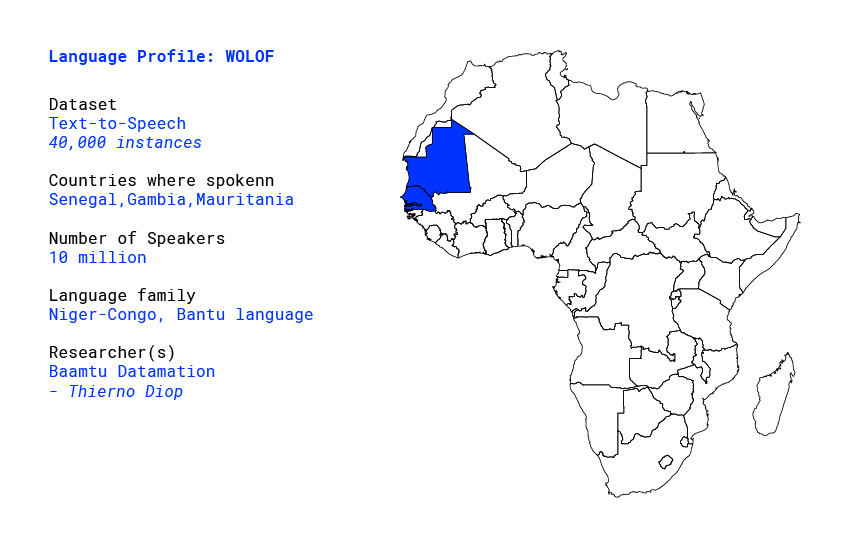Description
This dataset is part of a 3-4 month Fellowship Program within the AI4D – African Language Program, which was conceptualized as part of a roadmap to work towards better integration of African languages on digital platforms, in aid of lowering the barrier of entry for African participation in the digital economy.
This particular dataset is being developed through a process covering a variety of languages and NLP tasks, in particular a Text-to-Speech dataset of Wolof.
Language profil: Wolof

Overview
Wolof /ˈwoʊlɒf/[4] is a language of Senegal, the Gambia and Mauritania, and the native language of the Wolof people. Like the neighbouring languages Serer and Fula, it belongs to the Senegambian branch of the Niger–Congo language family. Unlike most other languages of the Niger-Congo family, Wolof is not a tonal language.[1]
Pertinence
Wolof is spoken by more than 10 million people and about 40 percent (approximately 5 million people) of Senegal’s population speak Wolof as their native language. Increased mobility, and especially the growth of the capital Dakar, created the need for a common language. Today, an additional 40 percent of the population speak Wolof as a second or acquired language. In the whole region from Dakar to Saint-Louis, and also west and southwest of Kaolack, Wolof is spoken by the vast majority of the people. Typically when various ethnic groups in Senegal come together in cities and towns, they speak Wolof. It is therefore spoken in almost every regional and departmental capital in Senegal.[1]
Nevertheless, in Senegal, while the communication in schools and formally registered companies takes place in french, Wolof remains the most used language in critical settings such as :
- Market places
- Medical centers
- In apprenticeship for a major array of occupations such as hairdressing, tailoring, engine
- repairing, carpenting, agriculture among other manual jobs.
- at police stations
- in banking or telecommunications agencies
- in shops and restaurants
Existing work
Senegalease Government has created a linguistic Department for Wolof and other local languages to promote the use of Wolof in some environments like school and also translation of different book in Wolof languages, but there is still a lot of work to have Wolof used in official documents and schools. There also exist some french-wolof dictionaries. In the academic world, some work has been done to better understand Wolof Phonemes[2], POS[3], automatic translation of wolof to french[4], Automatic Speech Recognition From a startup called BAAMTU.
Researcher Profile: Thierno Diop
Thierno Ibrahima DIOP My name is a computer science engineer. He is lead data scientist at Baamtu and passionate about NLP and everything that revolves around machine learning.he has been mentoring data scientist students and apprentices for two years.
Before getting into data science,he did a lot of freelancing in the development of web and mobile applications for local and international clients. he is co-founder of GalsenAI, an artificial intelligence community in Senegal, he is also ZINDI ambassador in Senegal and co-organizer of GDG Dakar.
Partners

Disclaimer
The designations employed and the presentation of material on these map do not imply the expression of any opinion whatsoever on the part of the Secretariat of the United Nations concerning the legal status of any country, territory, city or any area or of its authorities, or concerning the delimitation of its frontiers or boundaries. Final boundary between the Republic of Sudan and the Republic of South Sudan has not yet been determined. Final status of the Abyei area is not yet determined.


